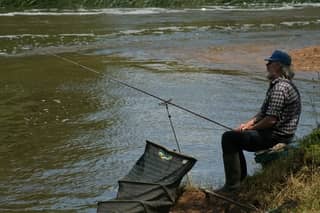
When I was just getting into fishing with my wife and kids one of the things I struggled with was how long should I be leaving my bait in the water in order to attract the fish. I didn’t know how often I should be checking it or moving it around if I wasn’t getting any bites.
There were times when I’d been sitting there for a long time, patiently waiting for the fish to come by and find my hook, and not seeing any action. I’d finally reel in to discover some sneaky fish had come along earlier and stole my bait without my noticing revealing that I had been trying to catch a fish all that time with an empty hook!
Whether you’re using live bait suspended from a float, salmon eggs, marshmallows, or dough bait there’s always the concern that you’re bait’s diminished or been taken without your noticing it. It’s necessary to check often and replenish your bait as needed, but you don’t want to be pulling what you’re offering out of the water away from your potential catch without ever giving the fish a chance to find it and take it. You can’t catch fish with a dry hook – keep your line wet!
So how long do you let it sit there before you should reel in and check?
Well, it depends 🙁
Many anglers believe the bait should be kept in one spot so the fish can eventually find it by sight and smell. If you reel in too soon, you may not be giving the fish the time they need to find what you’re offering. You also might discourage them from investigating something that takes too much effort to grab. Taking away what might otherwise could have been an easy meal.
I’ve found If the fish are biting you’re going to want to be checking more frequently for missed hook sets. Sometimes you’ll get hits while the bait is falling. If that’s the case you’ll want to check after each missed strike to see if your quarry got away with your bait.
If however your timing isn’t right and the fishing is slow then it becomes necessary to give the fish a few more minutes to find what they’re looking for.
Though there are no hard and fast rules – In short, if you haven’t had a bite in 10 or 15 minutes, you probably want to do a little check. Sometimes just lifting the rod tip will be enough to trigger a strike for any fish that have been hanging around inspecting your bait.
Some recommend moving the bait a foot or two per minute, working it back in slowly as fish often cruise around a lake or pond at a certain depth. Moving the bait a little at a time and then waiting can help you figure out where the fish are.
What if I waited and checked 3 or 4 times and each time I checked my bait was still good?
At what point do you decide to switch your method? If you reel in to check your bait due to no activity and your bait is still good, try casting a few feet away from where you were. After two or three checks and no activity it’s probably time to try and switch it up a bit with different depths, changing bait, or moving to a different spot.
Try shortening your leader 6 inches or so a couple of times. If however you notice that you keep getting some weeds stuck on the hook, try lengthening your leader to a couple of feet.
Try a different color/flavor of bait – sometimes they’re just not interested in purple and will go for chartreuse instead. This is where fishing as a team can come in real handy. One partner can try the green dough while the other tries out the orange. Turns out, my wife almost ALWAYS picks the better color and out fishes me 3 to 1!
What if my bait is gone every time I check?
If hook is empty every time you check, the issue may be that the bait isn’t attached securely in the first place and falling off on the cast or shortly after. One method I prefer when using dough bait to keep it from falling off the hook would be to take a pinch and squeeze it all around the hook and pinch it up past the eye of the hook up onto the string a little – creating a rain drop shape as opposed to just the recommended ball. Then give it a dip in the lake for a few seconds to help it harden a little before you cast. Also, fresh bait is less likely to crumble and fall apart.
It’s also likely the fish are being really sneaky and taking it without your noticing. Make sure to keep your hands on the reel – with a finger touching the line. Remove any slack and lift the rod just as soon as you feel a nibble or tick.
Keep a close watch on the line as the bait is sinking to see if it moves, sometimes you’ll get a bite on the way down and you’ll see the line move a little towards the side or even towards you. Again, right when you see the movement, reel in the slack and lift the rod to set the hook.
Learning to get a feel for how frequently to check your line can take some time and is actually more of a developed art than a science. It’s important to be patient with yourself as much as the fish as you develop your skills and enjoy being in the outdoors.
